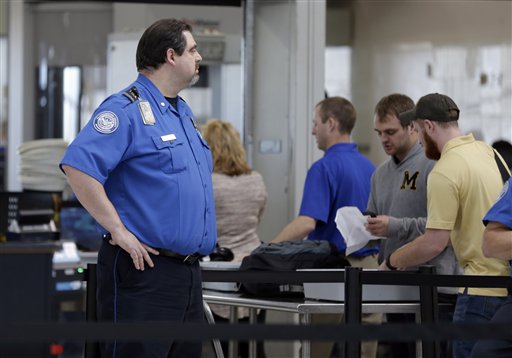As travelers suffer through long airport security lines, the Transportation Security Administration is spending millions on advertising, public relations, new uniforms, and office furniture.
The agency has blamed budget constraints for the nightmarish lines, which have caused 4,000 Americans to miss their flights and 100 travelers to sleep on cots overnight at Chicago’s O’Hare airport.
However, an analysis of recent government contracts reveals that over the past month the TSA has spent more than $2 million on various services unrelated to increasing manpower or improving security.
The agency awarded a public relations contract worth $53,234 for news clippings and media monitoring from a company that worked with President Barack Obama’s 2012 reelection campaign.
Cision cites Obama’s campaign as a "success story" and credits its data operation for his victory over Republican nominee Mitt Romney. The company said the campaign used their "social intelligence software to monitor social and assess conversations of key audiences in swing states and respond accordingly."
"The ability to collect and analyze data on a large scale allowed the Obama team to model behaviors and target communications," Cision said. "The Obama team could, for example, predict which types of people could be persuaded by which forms of contact and content."
The TSA now wants the company to provide "web-based news clipping" and a "media directory subscription." When asked for more information about the services, a spokesperson for Cision said he could not provide specific information about their contracts.
"At a high-level, Cision provides media intelligence software that helps clients reach, engage and analyze media conversations to guide their PR and communications initiatives," they said.
The TSA is also spending heavily on advertising. This month the agency rehired a communications firm that in the past was in charge of the TSA’s "brand strategy."
The $1.7 million contract is for "continued marketing services and additional advertising support." Sage Communications, LLC will provide Google text ads, online ads on travel related websites, video ads, Facebook and Twitter ads, as well as develop a "media plan and social media strategic communications plan."
Sage Communications will also monitor and report on the results of its social media and advertising campaigns.
"At Sage Communications we bring our passion to creating stories that inform, educate, persuade and shape perception to create relationships and impel action," the company says.
The company previously worked on branding the TSA’s Pre-Check program, which provides expedited screening for Americans willing to pay $85.
Sage Communications said it studied the TSA’s security lines and found that travelers viewed "security screening as an interruption to their travel experience."
"Our creative challenge, therefore, would be to make screening both relevant and enabling to their entire travel experience, from pre-travel planning and commuting, through the airport and flight, and ultimately arrival–turning a place of ‘no’ into a place of ‘yes,’" the company said.
Sage Communications then used a "rational-emotional framework to create an engaging campaign theme connecting the idea of smarter security with achieving key traveler goals."
"Sage’s ‘be there’ campaign tapped into each traveler’s differing idea of what ‘destination’ means: a successful business meeting; a gathering of friends and family; even summiting a mountain," the company said. "Sage produced creative executions for all these scenarios, and applied our understanding of the total travel experience to identify the right media partners for this message and deliver it across that experience."
The "Be There" ads featured a man having a very pleasant time sipping on an espresso before he leisurely strolls through security, a striking contrast to the current TSA experience.
The agency also recently spent $1,790 for a subscription to Politico Pro.
Aside from marketing and advertising spending to strengthen its image, the TSA has also billed the taxpayers for new furniture, uniforms, and badges in recent weeks.
The agency spent $196,461 on furniture from Federal Prison Industries, Inc., including contracts for a conference room and new furniture for the Los Angeles International airport.
The TSA also spent $31,589 for men’s instructor uniforms from VF Imagewear, Inc., which also promises to help "your brand image."
"First impressions are formed in seconds," the company says. "The right uniform program ensures your brand image will be enhanced from the first smile or handshake."
The agency spent $8,600 for badges for personnel in Honolulu, Hawaii, and $14,790 for a "digital virtual assistant."
The contract between the TSA and Airus Media, Inc. is for a small international airport in Plant City, Florida. The company created a female hologram named Ava that can be used as an "airport ambassador."
"Ava is the latest solution in next generation airport security, way-finding, and promotion," the company explains. "The future is here! Meet Ava—your hologram airport virtual assistant. She works 24 hours a day, seven days a week, and doesn’t charge for overtime. She never gets sick and doesn’t require a background check."
"You’re right, I’m really not here, but I do look pretty good, don’t I?" the avatar says in an introductory video.
"I can say what you want, dress the way you want, and be just about anything you want me to be," Ava says.
The TSA has used the hologram to tell passengers where to go at the San Antonio International airport, and the Port Authority of New York and New Jersey purchased three Ava’s from the company for LaGuardia, Newark, and John F. Kennedy airport.
The TSA has said tighter budgets are to blame for the long airport lines because of fewer security screeners. Request for comment on its recent spending was not immediately returned.
